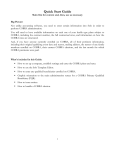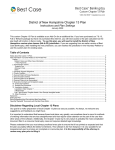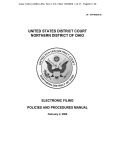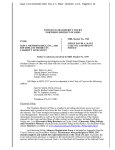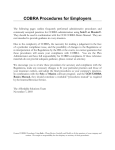Download COBRA Procedures and Basic Compliance Rules for Employers
Transcript
COBRA Procedures and Basic Compliance Rules for Employers Caution: COBRA TPAs must use discretion in using these suggested procedures as their deadlines and processes may be different. The following pages outline frequently performed administrative procedures and commonly accepted practices for routine COBRA administration using the Solo COBRA management program. They should be used in combination with other resource material available to you. These procedures do not include procedures for other regulations such as the federal ARRA subsidy program. We encourage you to review these procedures for accuracy and compliance with the Regulations, make any necessary changes to fit your particular practices and those of your insurance carriers, and adopt the final procedures as your company’s practices. Due to the complexity of COBRA, the necessity for making a judgment in the face of a particular compliance issue, and the possibility of changes to the Regulations or reinterpretation of the Regulations by the IRS or the courts, we cannot guarantee that these procedures will assure your compliance with COBRA. You are the Plan Administrator and have full responsibility for COBRA compliance. If these reference materials do not provide adequate guidance, please contact an attorney. The Affordable Solutions Team [email protected] July 2010 1 Table of Contents PROCESSING TIMELINES ........................................................................................................ 3 Regular Processing ........................................................................................................................................................ 3 Processing Triggered by Receipt of a Notification ................................................................................................... 4 NEWLY ENROLLED EMPLOYEES AND SPOUSES ........................................................................ 5 ISSUE THE GENERAL NOTICE ................................................................................................ 5 RECEIVE NOTICE OF AN INITIAL QUALIFYING EVENT.............................................................. 6 ISSUE THE ELECTION NOTICE................................................................................................ 6 RECEIVE A COBRA ELECTION AND THE INITIAL PREMIUM ...................................................... 7 RECEIVE AND ADMINISTER COBRA PREMIUMS ....................................................................... 8 RECEIVE NOTICE OF A SECOND QUALIFYING EVENT............................................................... 9 RECEIVE NOTICE OF DISABILITY FROM THE SSA ................................................................... 10 OPEN ENROLLMENT OR CHANGE IN COBRA RATES ............................................................. 11 TERMINATION OF COBRA .................................................................................................. 12 RECEIVE A CHANGE IN STATUS NOTICE ............................................................................... 13 OPEN ENROLLMENT AND COBRA ....................................................................................... 13 2 Processing Timelines The following is a brief outline of how you might structure your processing timelines and activities during a month and throughout the year. For more specific information, refer to the following pages. Tip: You should open Solo at least monthly in order to view the Reminder Reports. I would recommend between the 1st and the 10th of each month. Regular Processing General Notices • Once a month. • Your deadline is 90 days from enrollment on a COBRA plan. • Establish an internal process wherein you are notified of any new active plan enrollments. This includes an employee and covered spouse. If a spouse is added later, you will need to be notified of their addition so you can issue them the General Notice. Election Notices – terminations, reduction in hours, and death of employee • Once a month (minimum). • As an “employer administrator”, your deadline is 44 days from the date coverage is lost due to termination or reduction in hours. • Establish an internal process wherein you are notified of any losses of coverage due to a qualifying event. Election Notices – divorce, legal separation, and loss of dependent status • Upon timely notification of a qualifying event from the employee or dependent losing coverage, you have 14 days to issue the notice. • Sometimes, you will be notified of a loss of dependent status (usually age) from a carrier. Upon that notification, you may need to check for loss of coverage under another carrier’s plan as not all carriers will notify you. Maximum Continuation Notices • Once a month. Use the Reminder Report as a trigger. • There isn’t a fixed timeline but these should go out at least 60 days in advance of COBRA expiration. Payment Posting • Once a week if there are payments to be posted. Late Premium Warning Letter (optional) • Around the 20th of the month. Use the Reminder Report as a trigger. Prior to issuing the letters, you should make sure all payments are posted. Open Enrollment (once a year) COBRA participants have the same rights at open enrollment as active employees. You will need to send them a packet and, upon receipt of their new elections (if any), you will update their “elections” and send them a rate change type confirmation letter and new payment instructions. If they don’t make a change, you still need to update their elections for any new rates and send them a confirmation type letter. 3 Processing Triggered by Receipt of a Notification New Election Processing • Upon receipt of a signed Election Form, you should process promptly. There isn’t a deadline. Early Termination Notice – other than non-payment • Upon receipt of a notification of termination you will process the termination and send out a letter. Always get your termination notifications in writing. Early Termination Notice – non-payment • After the COBRA month closes and about a week passes to allow for mail time, you will process the termination and issue a letter. Changes in Plan Enrollment • Upon receipt of a request to change plans or enrollment, you should process promptly. • You will send out a confirmation type letter from Elections along with new Payment Instructions. Second Qualifying Events and Disability Extensions • Upon receipt of the notification from the COBRA participant or their representative, you should process the new notice (2nd QE) or confirmation of receipt letter (SSA disability) within 14 days. • Both processes have some “ins-and-outs” and can vary depending on the circumstances. Don’t hesitate to ask for assistance. 4 Newly Enrolled Employees and Spouses Issue the General Notice (Formerly the Initial COBRA Rights Notice) COBRA requires that the Plan provide notice of COBRA rights and obligations to covered employees and covered spouses within 90 days of the active coverage effective date. If coverage for a spouse is added after the employee’s, the spouse must be provided a notice at that time. It is critical that the notice be provided in a manner calculated to reach a covered spouse. Therefore, mailing the notice to the home is the most prudent method of delivery. Notified that an employee and, if any, a spouse is newly covered. When a spouse is being added as a dependent. Substantive change in COBRA regulations or regulatory guidance that prompts a re-issuance of the notice. Action by Plan Administrator Issue the General Notice and Notice of QE by adding the employee and a spouse, if any, as Active and, within 90 days of coverage, print the notice and mail to employee and, if any, the spouse at their home. Both names need to be on the Notice and on the envelope. Issue the spouse a General Notice. Add the spouse to the employee’s record. Print Notice and envelope and mail to spouse at their home. Print Notices and mail to all covered employees and, if any, covered spouses using proper mailing procedure. 5 Receive Notice of an Initial Qualifying Event Issue the Election Notice Termination, loss of hours, death of employee or employee entitlement to Medicare*: the “Employer” has 30 days to notify the “Plan Administrator” and the Plan Administrator has 14 days to issue the Notice. If the employer is also the Plan Administrator (as defined by ERISA), then the Plan Administrator has a total of 44 days to issue the Election Notice. *An employee’s entitlement to Medicare does not, typically, trigger a qualifying event for a spouse or child. Divorce, legal separation*, or loss of dependent status: an employee or qualified beneficiary has 60 days to provide notification of a qualifying event and the Plan Administrator has 14 days to issue the Notice. *A legal separation does not, typically, trigger a qualifying event for a spouse of other dependents. You will need to request proof that coverage will be lost. Before issuing the Notice: v Verify coverage was in effect the day before the qualifying event and that it will be lost. v If notice is required from the employee or qualified beneficiary, verify that it is within the 60-day notice requirement. v And, finally, don’t forget to notify the insurance carrier(s) that coverage is terminated. Receive timely notice of a COBRA Qualifying Event. An employee, spouse, or dependent provides notice of divorce, legal separation or loss of dependent status but is not entitled to COBRA. Action by Plan Administrator Issue an Election Notice. Within the 44 or 14 day deadline, create the Election Notice and mail to the qualified beneficiaries at their last known mailing address using proper mailing procedure that requires the name of the PQB and, if any, the spouse on the envelope. A recent court case suggests that USPS Certificate of Mailing be used to create firm proof of mailing. You need to provide an Unavailability of COBRA notice within 14 business days using proper mailing procedure. There is a template available in Help on the Solo menu bar. (If you are a COBRA TPA, this notice will be issued by the employer) 6 Receive a COBRA Election and the Initial Premium COBRA requires that an Election be made within 60 days from the date of RECEIPT of the notice. The initial premium is due 45-days from the date of election. Both elections and premiums are considered made on the day the form is sent. A verbal election should be treated as an election as long as the form is received within a specified deadline. When premium is received, reinstate coverage retroactively for the months for which payment was made. Action by Plan Administrator: v v v v v v v After timely receipt of the signed Election Form, change Response Result in PQB Status to Elected or, if the initial premium is not received, Elected Awaiting Premium until the premium is received. In PQB Status, enter the date the Election Form is received and, if applicable, the date the initial premium is received. Record benefit elections in Elections. Issue the appropriate Confirmation Letter from Letters in Elections. The “Notice of Second Qualifying Event, Disability or Change in Status” is automatically included with all confirmation type letters. Issue Payment Instructions or Coupons from that function box. When premium is received, record receipt of the initial premium in Premiums. Once the initial premium is received, notify insurance carriers of coverage reinstatement. Initial premium is not made within the 45- day deadline. v v v Change Response Result in PQB Status to Missed Deadline. You can issue a letter from PQB Status. Return any premiums received with a letter of explanation. You can use the Custom Letter feature. 7 Receive and Administer COBRA Premiums COBRA requires that Qualified Beneficiaries have a minimum 30-day Grace period from the beginning of the billing period for payment of premiums. Typically, the billing period starts on the first of a month. COBRA premiums can be paid monthly or in advance and can consist of multiple payments. YOU CANNOT REQUIRE PAYMENT IN ADVANCE OF EITHER THE DUE DATE OR THE END OF THE GRACE PERIOD. Due to the inherent lag in receipt of COBRA payments, you may find it necessary to pay the COBRA premiums for the qualified beneficiaries and consider their payment as reimbursement. Partial payments: if the payment received is insignificantly less than the amount due, the qualified beneficiary must be given at least 30 days to make-up the difference after notification by you. The regulations stipulate that premiums paid that are 10% or $50.00, whichever is less, of what is due are insignificantly less than the amount due. Alternatively, you can accept the “insignificant payment” as payment in full. Action by Plan Administrator: v Verify that payment is made within the grace period. Premiums are considered “made” on the date sent. Use the postmark if available. v Record the payment in Premiums. v If a partial payment is made within the “insignificant threshold”, record and allocate premium, create the Partial Payment Letter and mail using proper mailing procedure. Using the Partial Payment Report, monitor receipt of the balance. v If it is your stated policy, you can issue a Late Payment Letter prior to the end of the grace period. The Reminder Reports will indicate who has Unpaid Premiums. v If termination occurs due to non-payment, enter the Termination Date, select the Reason and issue the appropriate letter in the Termination function box. v Notify the insurance carrier that COBRA coverage has terminated. 8 Receive Notice of a Second Qualifying Event Extension to 36 Months This extension applies to family members on COBRA who are qualified beneficiaries. COBRA requires an extension to 36 months if, during the original 18-month or the 11-month extension due to disability period, a qualified beneficiary loses coverage due to the following qualifying events: Divorce, Legal Separation, Death of the Employee, Ex-employee’s Medicare Entitlement* or Loss of Dependent Status. They must notify you within 60 days of the qualifying event and, then, you must provide notice within 14 days. * This is, typically, not a second qualifying event for a spouse or child per a 2004 IRS ruling. Issuing a Notice of Unavailability of COBRA Coverage. If the notification is not timely or if the qualified beneficiaries do not meet the conditions of the notification rules outlined on the form or in the Election Notice, you will issue the Notice of Unavailability of COBRA Coverage within 14 business days. Start by going to Letters on the main menu bar and clicking on Notice of Unavailability of COBRA Coverage and follow the process. Make a copy of the notice for your files. Make a note in the notepad. Premium due date: Even though the payee may have changed, the premium is due within the Grace period. The initial premium payment rules do not apply to an extension. Action by Plan Administrator: v v v v v v v v Upon timely receipt of notice of second qualifying event, go to Family Status and initiate the Second QE procedure for the affected qualified beneficiary by clicking on the “2nd QE” button. This process will give the affected family member qualified beneficiary the status of a PQB and their data will be under their own record. Design the Election Notice and mail the 2nd Qualifying Event Election Notification using proper mailing procedure. Upon receipt of a signed form and/or the premium, in PQB Status change the Response Result from Pending Enrollment to Elected or Elected Awaiting Premium. Enter the final plan(s) in Elections and issue a Confirmation Letter that automatically includes a Notice of Second Qualifying Event, Disability or Change in Status. Issue Payment Instructions or Coupons. Record premiums as they are received. Notify the insurance carriers of the extension. Modify the record of the ex-employee PQB. This will include changing their plan election(s) to correctly reflect their new coverage status, i.e. employee only or employee and children, etc. Refer to the User’s Manual. 9 Receive Notice of Disability from the SSA Extension to 29 Months A disability extension of 11-months can occur if any qualified beneficiary in the family unit is disabled, as determined by the Social Security Administration (SSA), at any time during the first 60 days of COBRA and all notification requirements are fulfilled within the 18-month continuation period. The rules are detailed, somewhat complicated and are outlined in the notices and your CCH Manual. Premium may be increased to 150% of the applicable active plan premium during the extension as long as the disabled qualified beneficiary is part of the coverage group. Contact your insurance carrier(s) for information on their policy. This is an extension of COBRA coverage and the monthly premium must be timely made within the grace period. The initial premium payment rules do not apply. Note: All qualified beneficiaries in the unit have an independent right to elect the extension. The disabled qualified beneficiary does NOT have to participate. Issuing a Notice of Unavailability of COBRA Coverage. If the notification is not timely, the disability timelines not met, or if the qualified beneficiaries do not meet the conditions of the notification rules outlined on the form or in the Election Notice, you will issue Notice of Unavailability of COBRA Coverage within 14 business days. Start by going to Letters on the main menu bar and clicking on Notice of Unavailability of COBRA Coverage and follow the process. Make a copy of the notice for your files. Make a note in the notepad. Action by Plan Administrator: v v v v v v Before starting the process, contact your carrier(s) to confirm their policy for COBRA rates for SS Disabilities. If necessary, set up the Social Security Disability Plans in Setup and review the template in the Solo Notice Editor and make any necessary edits to the text. Upon receipt of SS Determination Letter, go to the COBRA qualifying event function box and check the Disability Tracking in Effect box at the bottom and follow the sequence of requested information. The software will assist you in determining if the deadlines are met. At the appropriate time, design a new Election Notice and mail using proper mailing procedures. If the disability extension is accepted by any of the qualified beneficiaries, you will change the status in PQB Status, enter the final plan Election(s), and issue a Plan Change or Enrollment Change letter that automatically includes a Notice of Second Qualifying Event, Disability or Change in Status. Issue Payment Instructions or Coupons. Notify the insurance carrier of the extension. 10 Open Enrollment or Change in COBRA Rates You are required to provide advance notice of a change in COBRA rates. And, with only a few exceptions, COBRA rates must remain in effect for the 12-month determination period that, typically, coincides with your insurance plan year. If you cannot provide advance notice, you may need to subsidize any rate increase until advance notice can be provided. In addition, COBRA enrollees have the same rights as active employees at open enrollment to change plans, add or drop dependents, etc. Action by the Plan Administrator: v v v v v Prepare an open enrollment packet for those enrolled on COBRA. The rate sheet may differ from that of active employees due to your COBRA rate structure, the 2% allowable load or the 150% allowable load for SSA disability extension. Include a Rate Change letter in the packet. You will update the COBRA rates in Setup. Then, for each family unit on COBRA, update their plan selections for the forthcoming year based on their current year’s election. Print a Rate Change letter that can be included with the packet. When their elections are returned, update the plan elections and issue a Plan Change or Enrollment Change letter, whichever is appropriate, that automatically includes a Notice of Second Qualifying Event, Disability or Change in Status. Issue new Payment Instructions or Coupons. Notify the insurance carrier(s) of any changes. Pending enrollment status: If you have COBRA qualifiers in a pending enrollment status who may be affected by this rate change, it is advisable to notify them of the rate change. You do not need to issue a new Election Notice. You can send them the new COBRA rate matrix with a cover letter. 11 Termination of COBRA A. Expiration of COBRA – notification is required under certain circumstances: If COBRA is terminating due to the expiration of the continuation period, then a notice must be mailed to the PQB and, if any, a covered spouse in the six months period prior to the expiration if other coverage, such as conversion coverage, is available. We recommend that this notice be issued in all circumstances as it’s a good business practice and avoids misunderstandings. Use the Maximum Continuation Notice found in Letters on the menu bar. It can be edited in the Solo Template Editor. B. Early Termination of COBRA – notification is always required: v v v v v v v Voluntary termination. Due to independent rights to elect COBRA, each family member can terminate COBRA independent of any other family member. Premium not paid on time. Premiums are paid on the date “sent”. Typically, measured by a postmark. Remember the insignificant premium shortfall rule. Medicare entitlement - after the date of the COBRA election. Other group coverage. After COBRA election, the qualified beneficiary becomes covered by another group health plan. If the new plan has pre-existing limitations or exclusions that apply to the qualified beneficiary, COBRA can be terminated only after the limitation or exclusion is satisfied. Plan is discontinued. Employer ceases to maintain any group health plan. No Longer Disabled. If the disabled qualified beneficiary is no longer disabled then coverage ceases for all qualified beneficiaries. They are required to notify you within 30 days. For cause. COBRA participant violates some contractual provision in a health plan that would cause termination for non-COBRA beneficiaries, e.g. fraudulent submission of claims. Action by Plan Administrator: v v v COBRA expirations. The Reminder Reports indicate COBRA expirations at 90 days. Issue a Maximum Continuation Notice from Letters on the menu bar. In Termination, enter the date and reason. Be sure to comply with any State regulations as they apply to Federal COBRA. The Maximum Continuation Letter can be edited in the Solo Template Editor. Early termination. If the full family is terminating, in the Termination function box, enter the date and reason and issue a Letter as appropriate. If a dependent is terminating, enter the Date COBRA Coverage Ends date in Family Data and, from Letters, issue the Dependent Termination letter. The Termination Letter can be edited in the Solo Template Editor. Notify insurance carriers of the termination. 12 Receive a Change in Status Notice If you receive a Notice of Second Qualifying Event, Disability, or Change in Status from an enrolled COBRA qualifier and you need to inform of a penalty for being outside the notification deadline or other requirements detailed on the form and in the Election Notice, you will use the Notice of Unavailability of COBRA Coverage letter. Start by going to Letters and the Unavailability of COBRA Coverage letter and following the instructions. Open Enrollment and COBRA COBRA enrollees have the same rights as active employees at open enrollment to add/drop coverage, add/drop dependents, etc. You must send them an open enrollment packet. If you need assistance with an open enrollment cover letter, please let us know. 13













